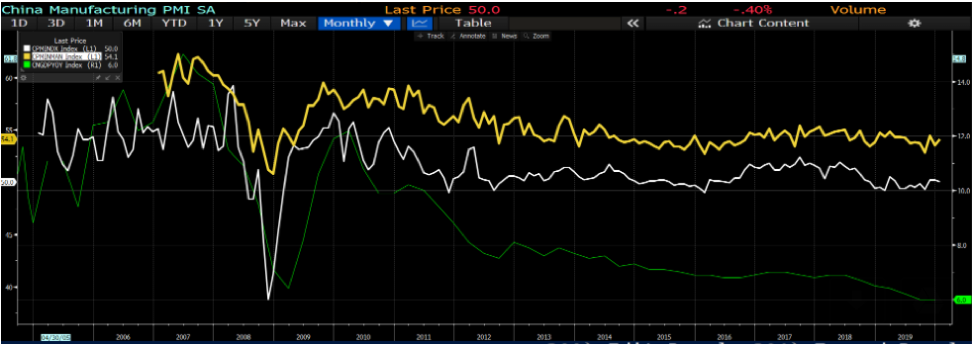CFDs are complex instruments and come with a high risk of losing money rapidly due to leverage. 72.2% of retail investor accounts lose money when trading CFDs with this provider. You should consider whether you understand how CFDs work and whether you can afford to take the high risk of losing your money.
- English
- Italiano
- Español
- Français
The official PMI is a diffusion index based on a monthly survey of supply chain managers in the manufacturing and service sectors. It is released by the National Bureau of Statistics (NBS). Reading above or below 50 indicates economic expansion or contraction.
Manufacturing PMI
Although the January Manufacturing PMI declined to 50, the lowest reading since last October, it was not able to fully reflect the impact of coronavirus, which started to outbreak in late January and has since spread across China.
Manufacturing PMI - yellow; Non-Manufacturing PMI - white; GDP growth - green

Source: Bloomberg
Despite the government having been recently encouraging people to return to work and ramp up production, a sizeable decline of the February reading is widely expected. The question is how far it will fall? The Bloomberg survey shows the median estimate for February is 45 (the lowest level since February 2009), with the lowest and highest sitting at 35 and 50.1 respectively.
Manufacturing PMI calculation incorporates five sub-component indexes with specific weight - new order (30%), output (25%), employment (20%), supplier’s delivery time (15%) and inventory of raw material (10%). The last three components were below 50 in January.
The ‘new order’ index will get the attention of market participants and is highly likely to suffer due to the quarantine measures seen in China (to different degrees) and suspension of business activities. Another sub-component ‘new export orders’ index fell to 48.7 in January from 50.3. A survey jointly conducted by Tsinghua University and Beijing University of 1435 SMEs shows that only 9.2% of these companies can survive more than six months relying on the cash reserves they have.
‘Output’ and ‘employment’ would no doubt take a hard hit as people are either not able to return to cities where they work or are forced into quarantine when they arrive. According to Bloomberg Economics, the economy is running at only 50%-60% capacity in the week to Feb 21. ‘Supplier’s delivery time’ will be extended due to the blocked highways and cancelled flights and trains.
Non-Manufacturing PMI
We saw the service data jump to 54.1 in January, indicating a stronger expansion in the service sector, which now contributes more than 50% to China’s economy.
However, the Bloomberg survey shows the February economists estimates range from 42 to 53.5, with the median sitting at 50, a record low if it was the case. We often see the market pay more attention to manufacturing, but in this case, a reading in the service data below 50.0 could be highly influential.
Industries like restaurants, travel agencies, airlines, hotels and shopping malls may suffer the most before and after the 2020 Chinese Lunar New Year, which is supposed to be the golden opportunity for the service industry.
Take 2019 as an example. According to China’s Ministry of Commerce, sales revenue from retail sales and restaurants during the 2019 New year holiday totaled 1 trillion yuan, and tourism contributed another half trillion.
What’s the impact on the financial market?
Because China’s economic growth has been slowing since 2010, the authority is now trying to perform a balancing act – slow the virus spread without hurting the world’s second-largest economy too much.
The PMI report will provide some early clues. Downbeat figures would continue to weigh on the Chinese Yuan (i.e USDCNH higher). However, far worse-than-forecast readings might force the PBOC to intervene and slow its depreciation. It would be the same case for the stock market (CN50 on MT4/5), which is more likely to be supported by the monetary policy or fiscal stimulus should we see some extremely terrible prints. The AUD, as a proxy of China’s economy, will respond swiftly and negatively to the PMI report.
We are increasingly seeing that the virus is spreading outside of China and one will question how much of economic fragility is priced into markets. There are rising concerns about global supply chain disruption and struggling world economic growth. Investors in a market full of uncertainty will head to safe haven assets like gold, US Treasury, and JPY until a clear circuit-breaker shows up.
For now, keep a close eye on the upcoming numbers and watch out for a potential gapping risk on the following Monday.
Ready to trade?
It's quick and easy to get started. Apply in minutes with our simple application process.
The material provided here has not been prepared in accordance with legal requirements designed to promote the independence of investment research and as such is considered to be a marketing communication. Whilst it is not subject to any prohibition on dealing ahead of the dissemination of investment research we will not seek to take any advantage before providing it to our clients.
Pepperstone doesn’t represent that the material provided here is accurate, current or complete, and therefore shouldn’t be relied upon as such. The information, whether from a third party or not, isn’t to be considered as a recommendation; or an offer to buy or sell; or the solicitation of an offer to buy or sell any security, financial product or instrument; or to participate in any particular trading strategy. It does not take into account readers’ financial situation or investment objectives. We advise any readers of this content to seek their own advice. Without the approval of Pepperstone, reproduction or redistribution of this information isn’t permitted.
